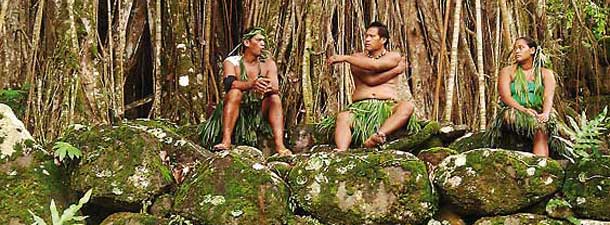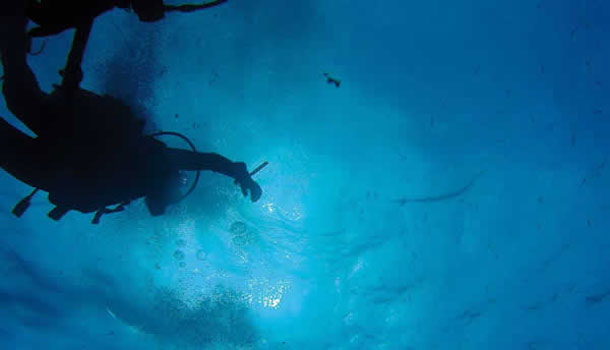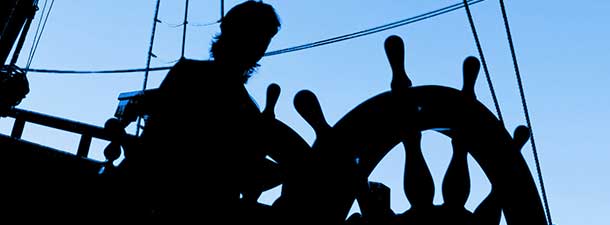
The Land of Men
July 1, 2012
What I’ve Learned in the Alleys
July 1, 2012
With its striking perpendicular cliffs and multitude of submerged caves, and teaming with marine flora and fauna, Sardinia has spectacular sights to offer both above and below the surface of the brilliant blue and green Mediterranean.
W
We set off on our diving adventure to discover the sea-beds around Alghero, Sardinia, also known as the Coral Riviera because of the large expanse of precious pink coral to be found there. What makes diving off Alghero so unique are the many underwater caves in the protected Marine National Park of Capo Caccia, a majestic limestone headland that is the unmistakeable feature of the Alghero skyline. In the park, we’ll find Nereo and il Porticato, two caves that offer scuba divers an experience to be found nowhere else. When diving in any of the protected underwater caves, you must be accompanied by authorised guides who know the seabeds and who can guarantee your safety while under water.

Alghero lido beach
We leave the port of Alghero in our boat, the Andrea Padre.* This mode of travel enables us to admire the old walls and gates of this ancient city, which started life as a small settlement of Catalans, a people who have left their mark in this part of Sardinia. We can also appreciate the beautiful marine park with its characteristic dramatic headlands, rising at a sheer vertical from out of the azure sea. The invisible hand of the winds has delighted in creating the most curious shapes in the rocks. In one place, on the crags on the island of Foradada, you can make out the face of the poet Dante Alighieri.

Stingray fish
We are accompanied by the heady aroma of Mediterranean maquis, a type of local algae, that lines the white rocky crags with its brilliant green. It suffuses with the aroma of the sea, creating an intoxicating sensory bouquet. The spectacle of the cliffs makes us lose track of time and we’re surprised at how quickly we’ve arrived at the first stage of our adventure: the Nereo cave – the largest underwater cave in the Mediterranean.

Moray eel
Nereo was discovered in the 1950s by the first coral hunters who plunged into the depths around Alghero. It is named after Nereo, the mythical father of the Nereids (sea nymphs). Dozens of lesser caves in the area bear the same name.

Red coral
When we get to our diving-off point, our guide gives us a briefing on the security procedures we need to follow. He goes over the standard set of signals to use under water and talks us through the route we are going to take in the caves, warning us not to touch the marine life there so as to preserve and safeguard it. Once we’ve all been briefed, we leave behind our main boat, setting out in the back-up rubber dinghy loaded with all our equipment. The diving-off point is right at the foot of the great sheer cliff face of the Capo Caccia. Here we can take in the breathtaking panoramic views, and then suddenly we make out the entrance to Nereo – a dark, gaping opening gouged out of the imposing limestone cliff. Pleasure boats come and go, ferrying visitors to this popular tourist spot; it can also be accessed by an immense set of steps that wind over the white rocks. Whichever way they get there, lucky visitors are treated to awe-inspiring sights.

Sea urchin
Once we’ve moored the dinghy, we put on our equipment and, one by one, we slip into the azure sea. We float on the surface as the last security checks are carried out. Soon we can begin our dive proper. Our guide asks us if we’re ready, we give him the final OK, and slowly we sink beneath the surface, diving down and down, keeping close to the cliff face underwater. The view that opens up before our eyes is absolutely stunning. The visibility is such that we can see the seabed straightaway, some grouper fish darting off as we approach. The only sound is from our scuba bottles. We are overwhelmed by a feeling of peace and tranquillity.

Nereo cave
The Nereo cave is the largest cave of its kind in the Mediterranean. There are two entrances: one at fifteen metres, the other at thirty metres. Depending on your level of experience, you can choose which section you want to explore. There is a main tunnel that goes on for 300 metres, so it is very large indeed, with secondary tunnels that branch off totalling another 500 metres.

Foradada Island
For our dive, we have chosen a route via the thirty metre entrance and we will be exiting after fifteen metres. Once we reach the seabed of rocks and white sand, we turn on our torches to light our way. As soon as we enter the cave, the tunnel slopes up and initially it is so dark, it can be slightly disorienting. With our lights, however, that feeling wears off and we are able then to wonder at the interior of this magnificent underwater cave. As we shine our torches onto the rock face, we notice patches of red. These turn out to be all that remains of the Rubrum coral that used to cover the whole area. Our beams flash into crevices and shafts. We catch sight of conger eels, sea raven, some cicada fish that dart away, scared off when the torch light hits them. A giant moray eel, dazzled, manages to escape into a rock crevice.

Outside Nereo cave
At the end of the tunnel, the view is spectacular – we’ve left behind the black darkness and can begin to discern the subtle shades of colours. Intense blue of every imaginable hue prepares you for the sight of the superb arches of the Nereo cave – an interplay of rock faces that come at you out of the blue – literally – and give you the sensation of being in an aquarium. Right on cue a shoal of sea-bream swims past near the cave.

Blue coral
The arches are covered with Parazholanths, known as the daisy of the sea. They are a deep intense yellow, covered with tiny filaments that look like petals. As we move through these arches, we get the feeling of gliding over country meadows, while on the rock faces, we notice what look like small coloured mirrors, only to realise it is the effect produced by our air bubbles caught on the rock surface.

Cicala
As we emerge from the cave we immediately feel the rays of the sun, the temperature of the water warming slightly. Slowly but surely we make our way back to the surface where the dinghy is waiting for us. As we break the surface, we are greeted with a new panoramic view different from where we started, with the sun lighting up the brilliant white cliffs.
The experience of that day will live with me forever, but never more so as when a lovely English lady, so bowled over by her dive through the delights of the Nereo Cave, completely forgot her traditional English reserve and let out a wild shout of joy, releasing all the emotions she had just experienced – “BEAUTIFUL! AMAZING! BRILLIANT!” Her words echoed round the Capo Caccia headland, leaving us all with broad smiles on our faces.

Andrea Padre
For our second dive we head to the Porticato, just off the island of Foradada. It’s called Porticato because of the numerous arches to be found there. Facing out from each other, all different sizes and with those characteristic small passage-ways and great arcades – il Porticato is another underwater journey of marine wonders. The entrance is at 18 metres and as we pass through it, we admire a myriad of small and large openings that create a multiplicity of light effects; the sides are covered with Parazholanthus and Lepsamine, producing a veritable work of art for the scuba diver to admire. But what marine photographers really appreciate when they attempt to capture the beauty of the cave is how the reflections of the sunlight, refracting through the limpid water, intensify the colours.

Alghero old town
In the last section of the arches, we come across an area of rocks and white sand that is a kind of antechamber to a small passage-way. About thirty metres long, it takes us to a small chamber, where the only light that reaches inside trickles down through several crevices. It is through one of the larger crevices that we make our way out from the cave, back up to surface of the turquoise-blue sea. On the way, as we keep close to the cliff face, we can still see to the seabed and are treated to the sight of some grouper fish swimming by. Slowly but surely we find our way back to the dinghy, and with heavy hearts we rejoin the main boat again.
Still, contentment steals over us as we wait. One of our group takes advantage of the lull to snatch some last photos in order to remember this day for ever.
The main boat picks us up and takes us to a small cove called Cala Inferno (Hell). It is, perhaps fittingly, only accessible by sea and mooring is off-shore. Don’t let the name put you off – there are two sides to every story! The winter version of the story of Cala Inferno is when the Mistral rages and vast waves come crashing down onto the rocks. Then there is the summer tale, when the colours of the calm water have such an intensity, moving from turquoise greens to deep azure blues that it literally takes your breath away.
In this little shallow bay you can get a good taste of scuba diving if you ever want to try your hand at discovering the delights of this sport – that feeling of swimming in a vast natural aquarium. People of all ages can have a go as long as they are in good health, are familiar with water sports, and adhere to the security standards set out by PADI (Professional Association of Diving Instructors) and by scuba diving associations affiliated to the Italian National Federation.
Back on board the main boat, there is a tasty meal waiting for us – an assortment of dishes sourced from both sea and land. Antipasto comprises of a local salame and Sardinian cheese, followed by a starter of crab spaghetti; the main course is a succulent dish of cockles marinieres, all washed down with a lovely local white wine. As is the local custom, you can’t finish lunch without a good strong espresso coffee but here it is accompanied by a typical Sardinian liqueur – il Mirto – made from myrtle berries.

Sunset from Alghero
After this banquet, we take a dip in the small bay by way of relaxation and then enjoy a couple of hours sunbathing on the beautiful sandy beach. Finally, we set off on our return journey to Alghero, where our magical voyage had begun, each one of us contentedly mulling over our own personal memories of an unforgettable day.
For more information on diving trips in Sardinia, visit www.divinginsardinia.com or telephone direct (Italy) 00 39-347-881-1280.
*It is the tradition in this part of Sardinia to name fishing boats after the oldest fisherman of the village. The boat now is fully equipped for transporting people.
Translated by P. Rham.




